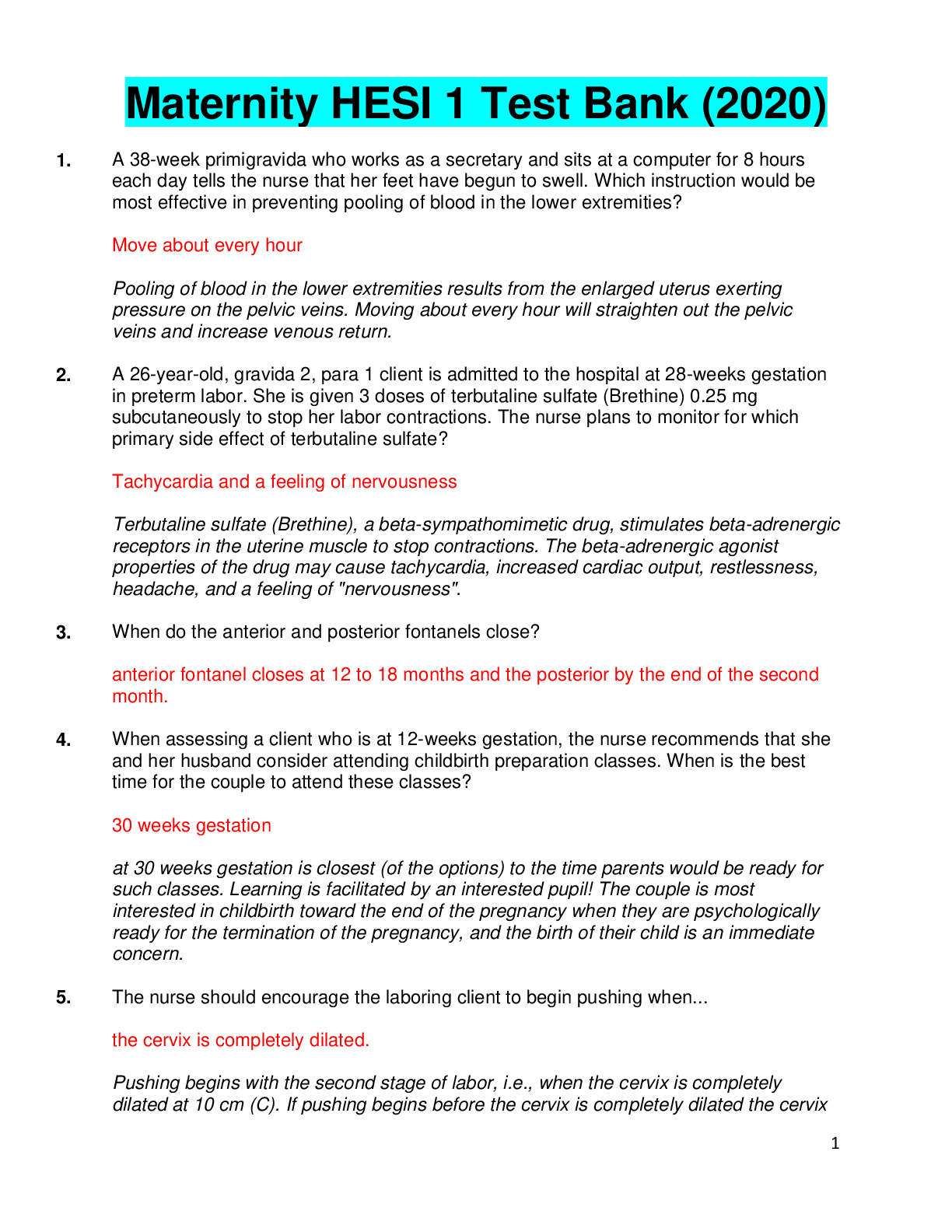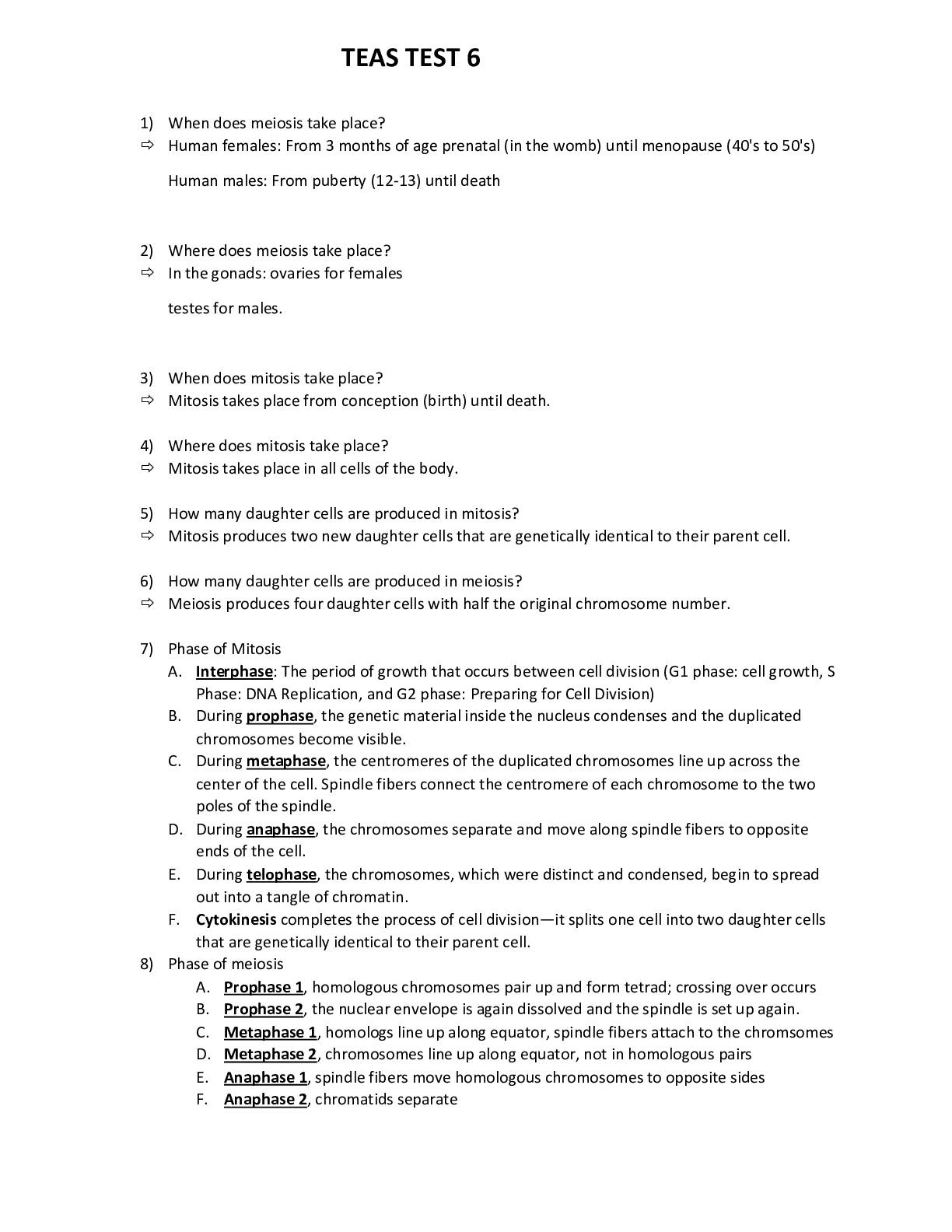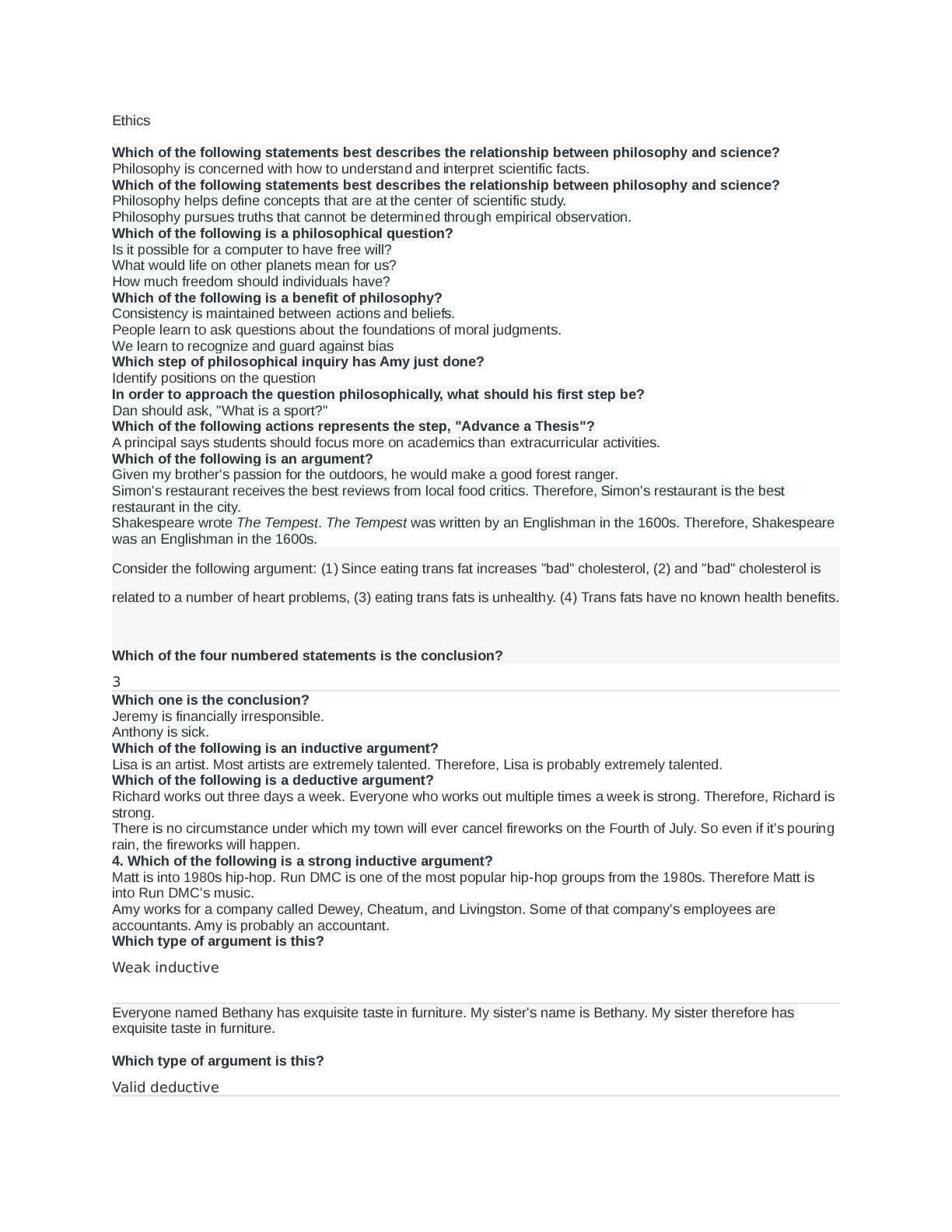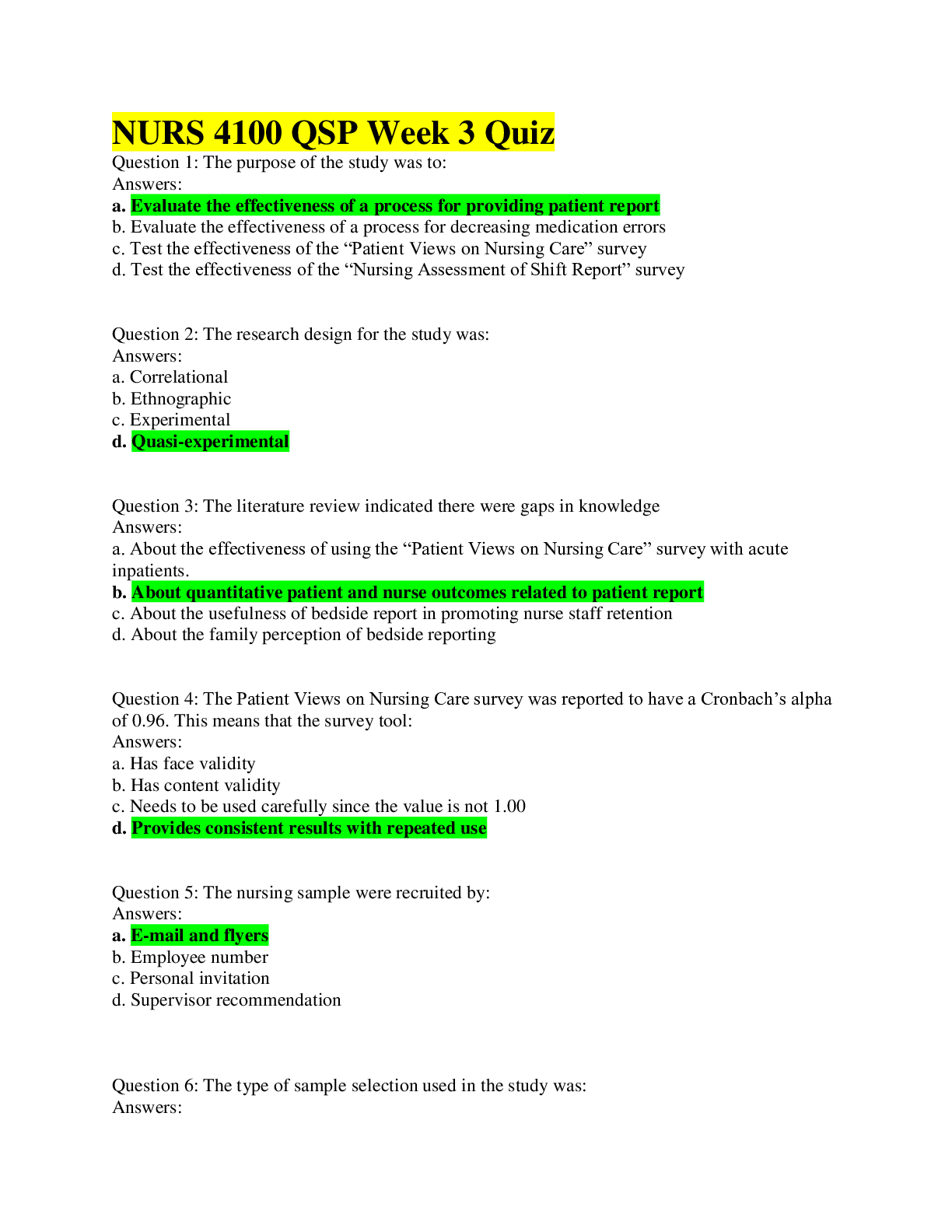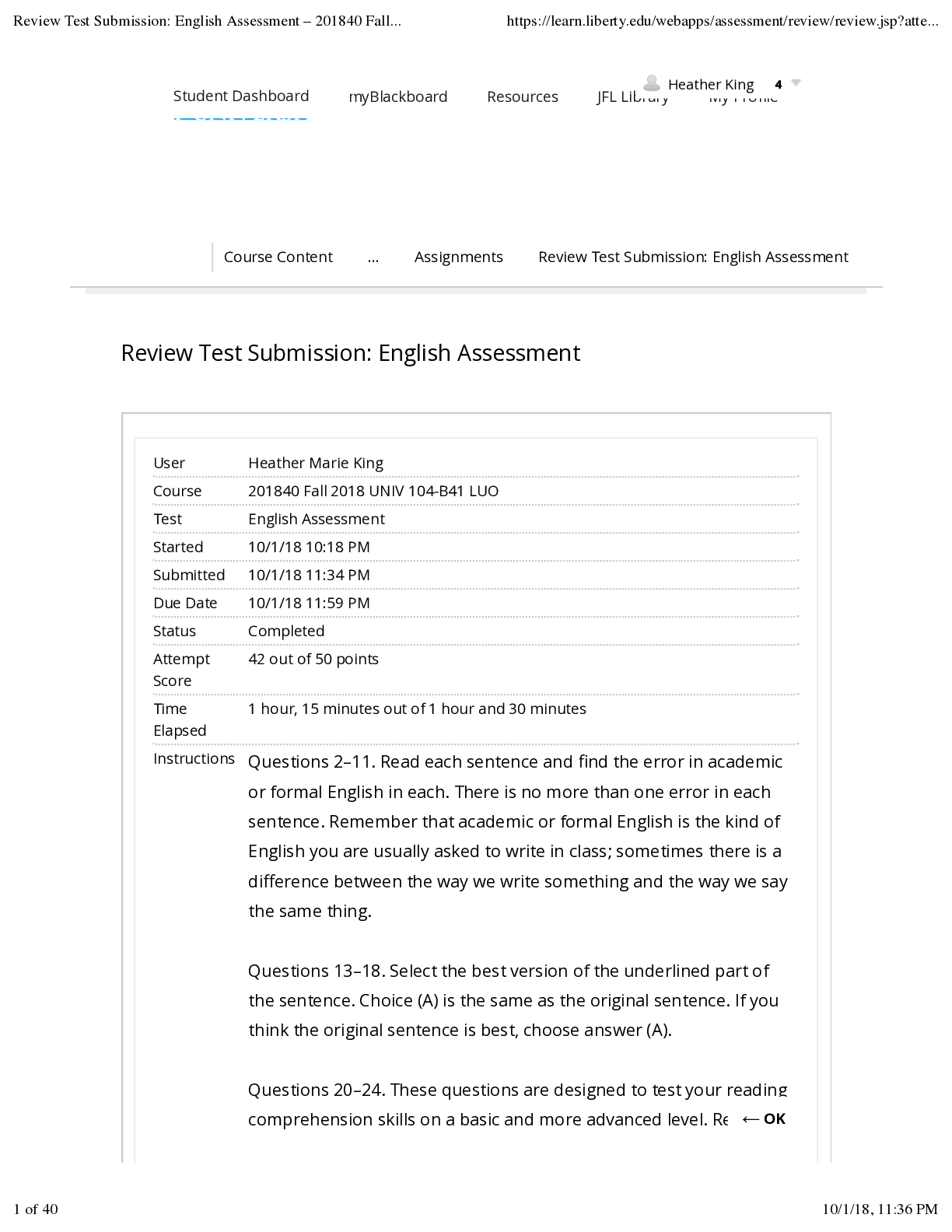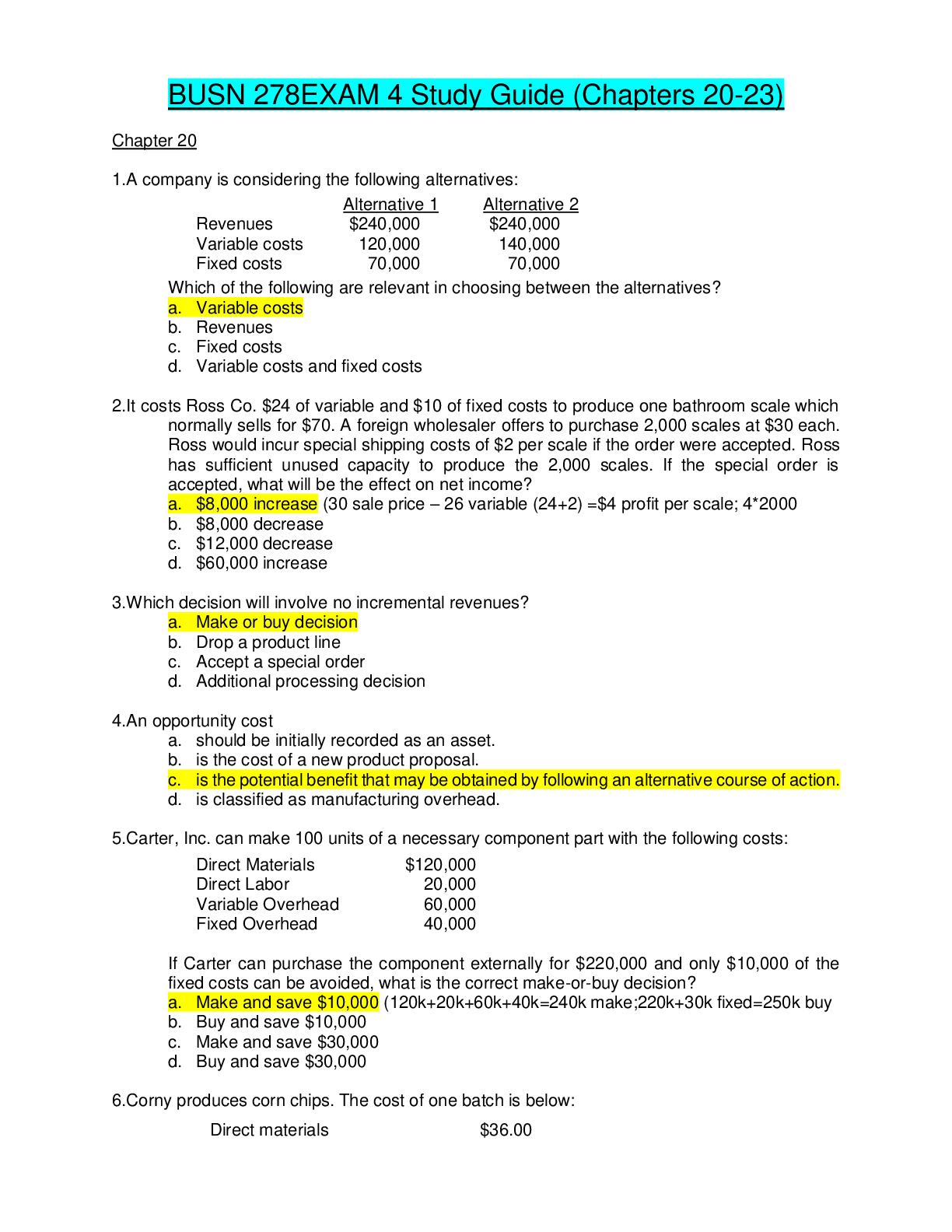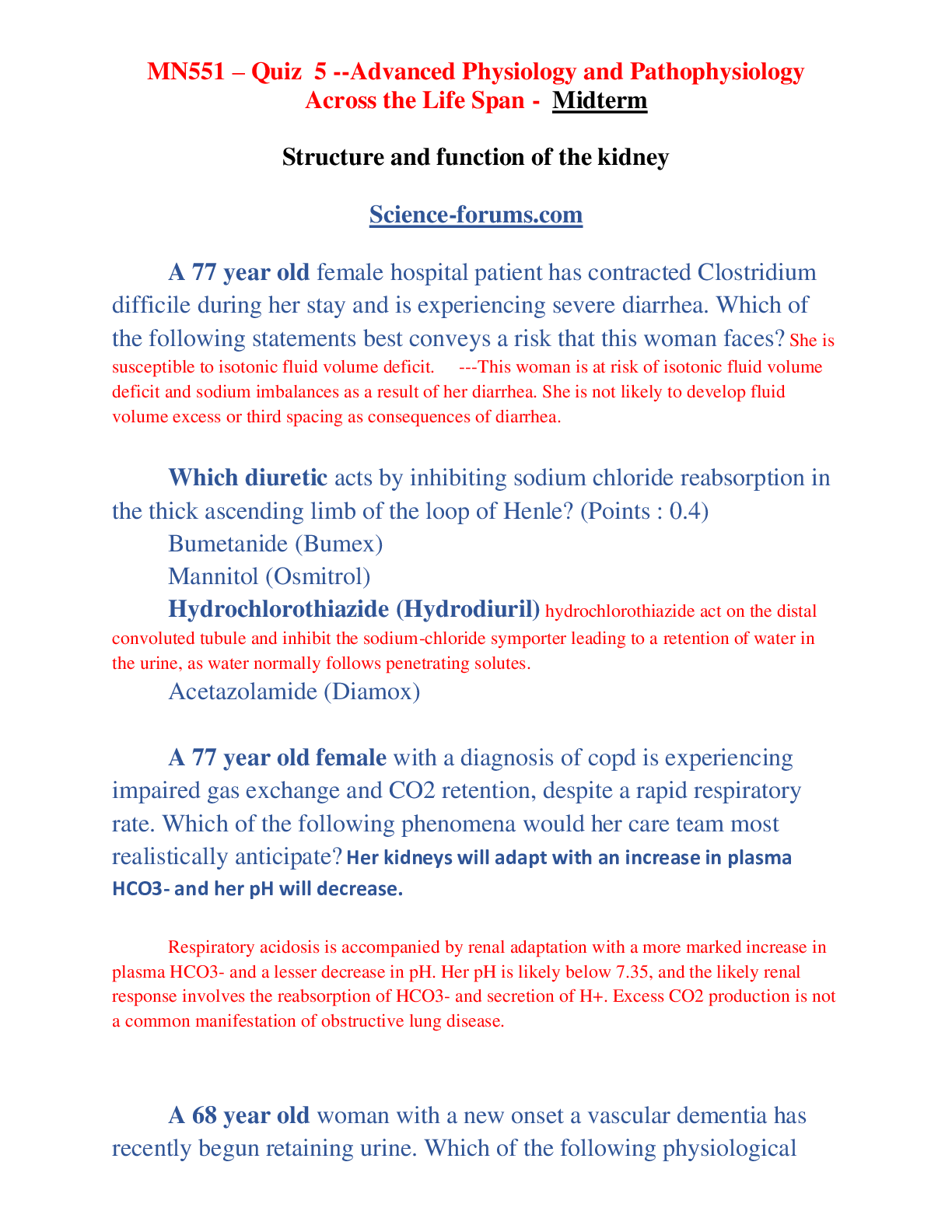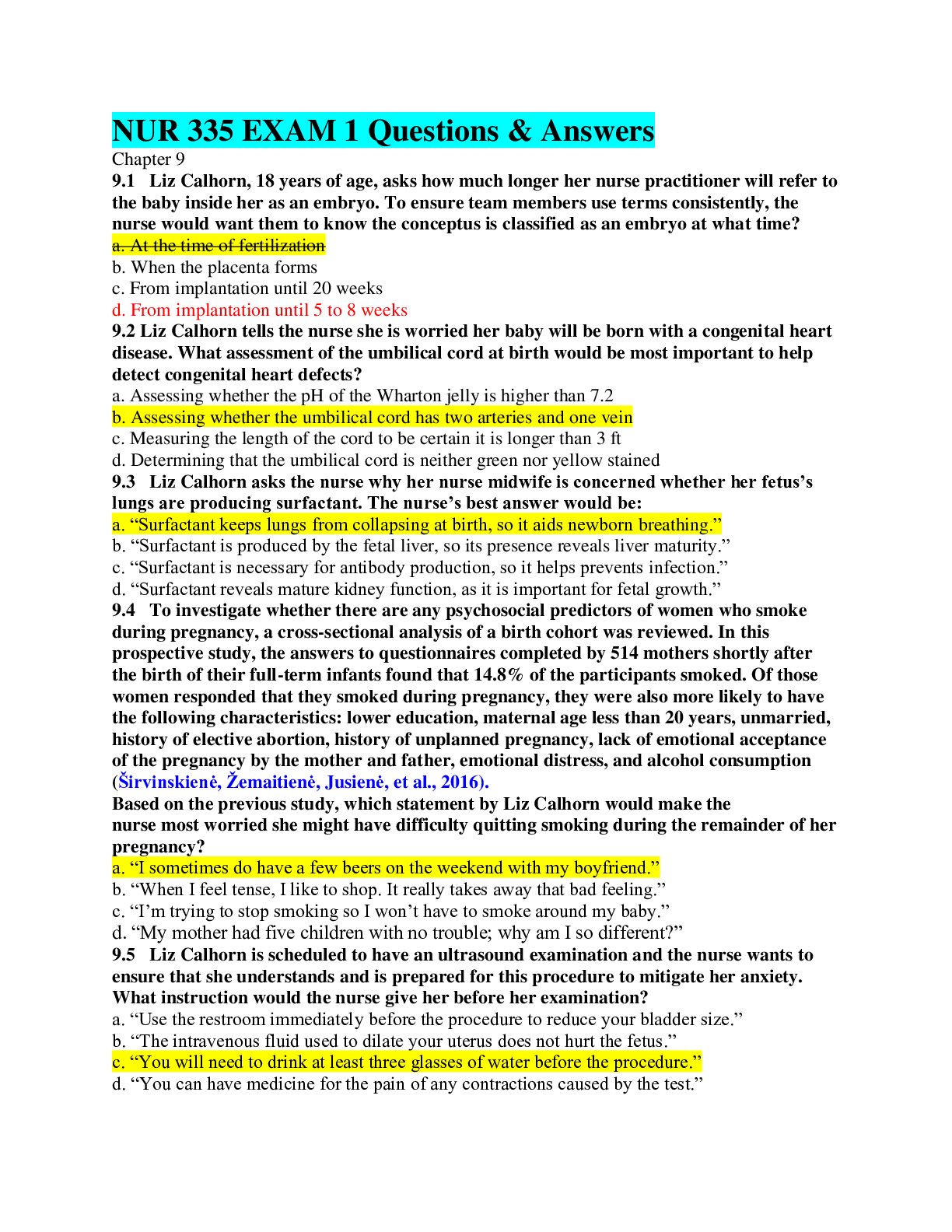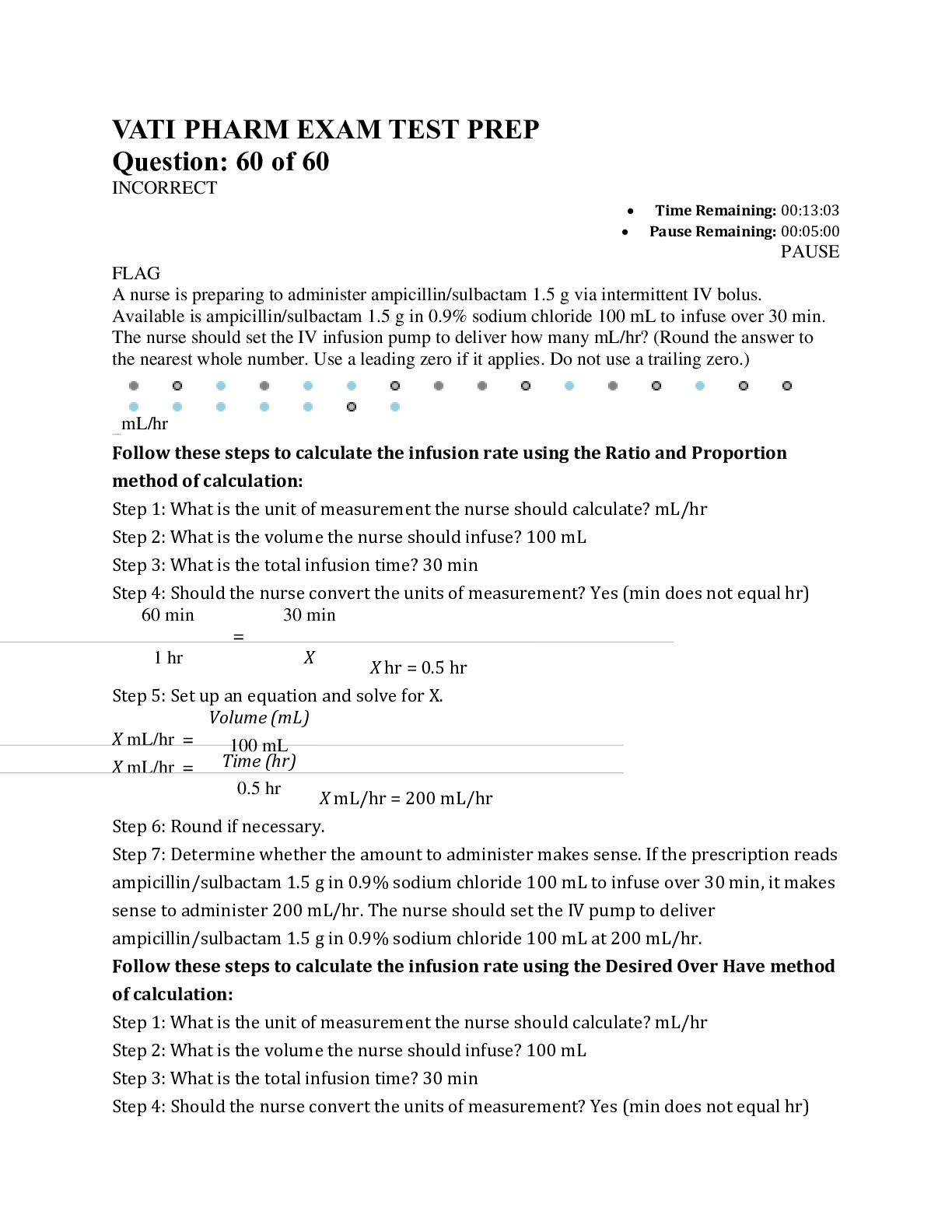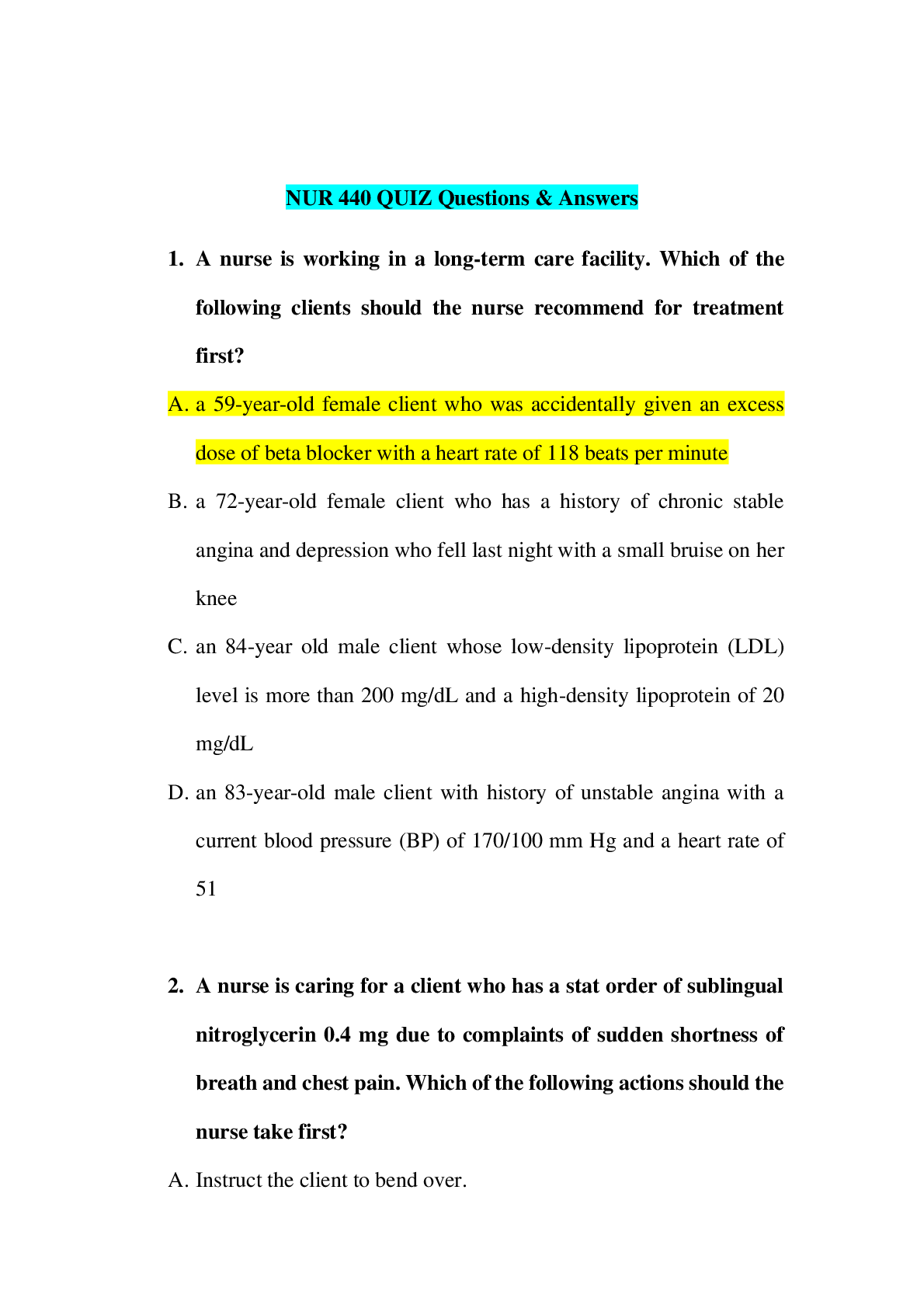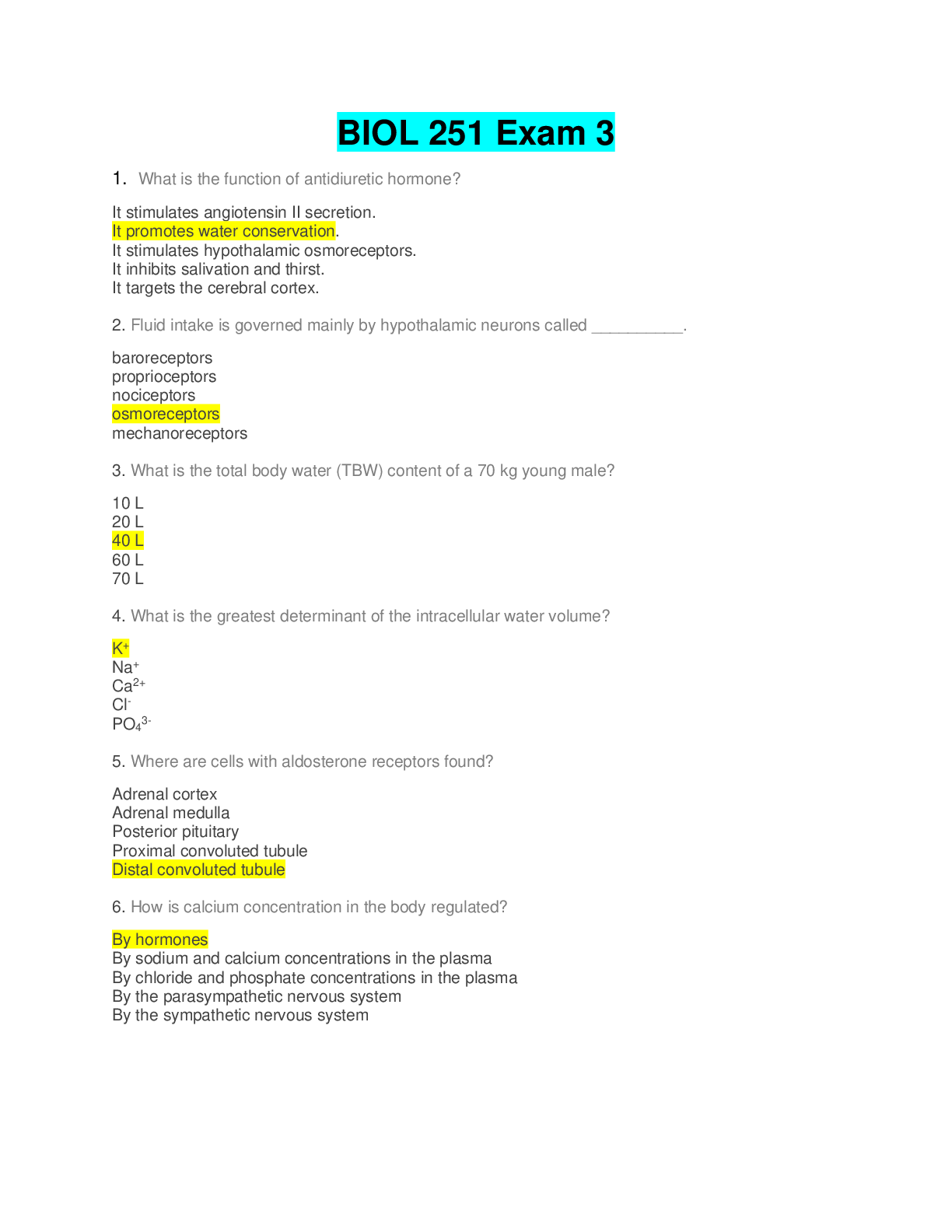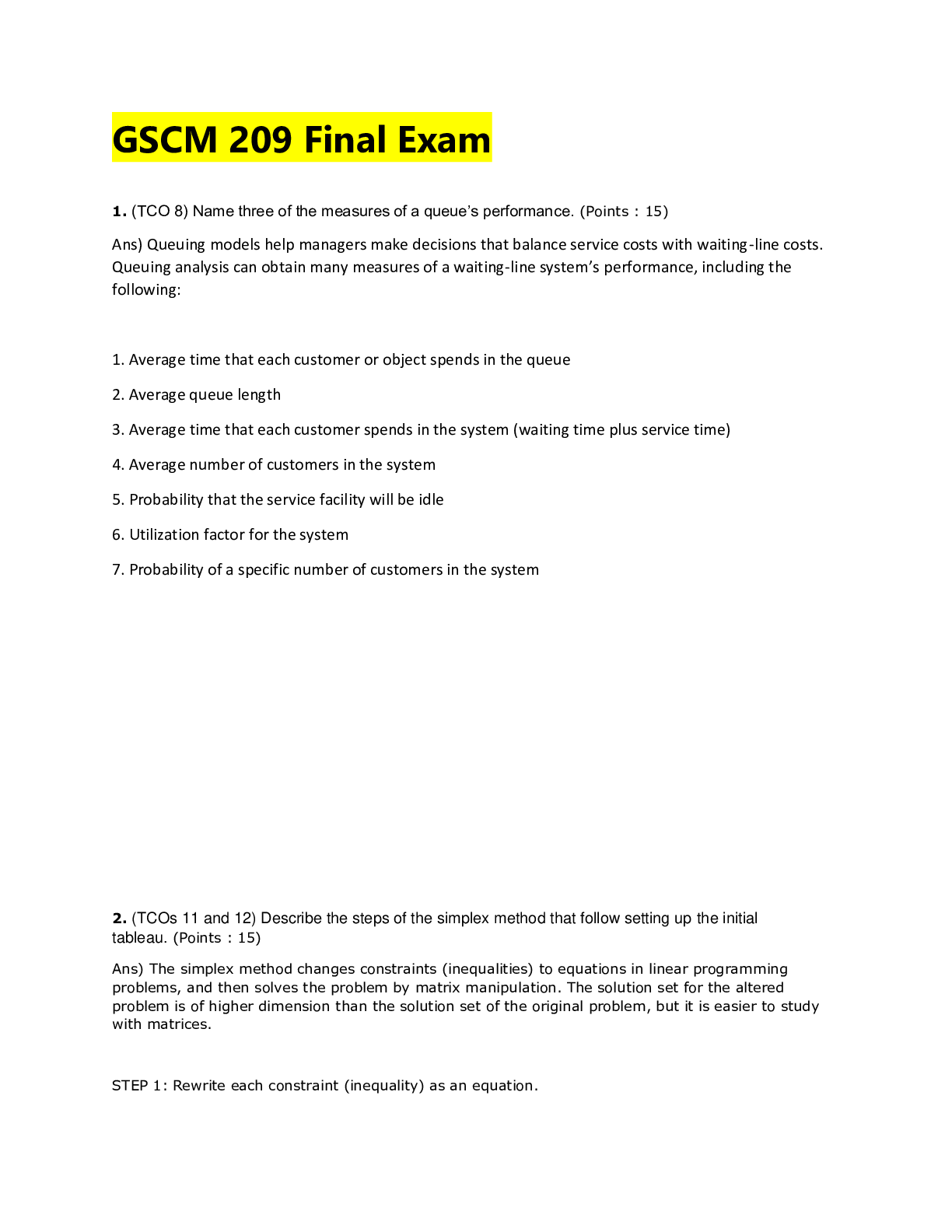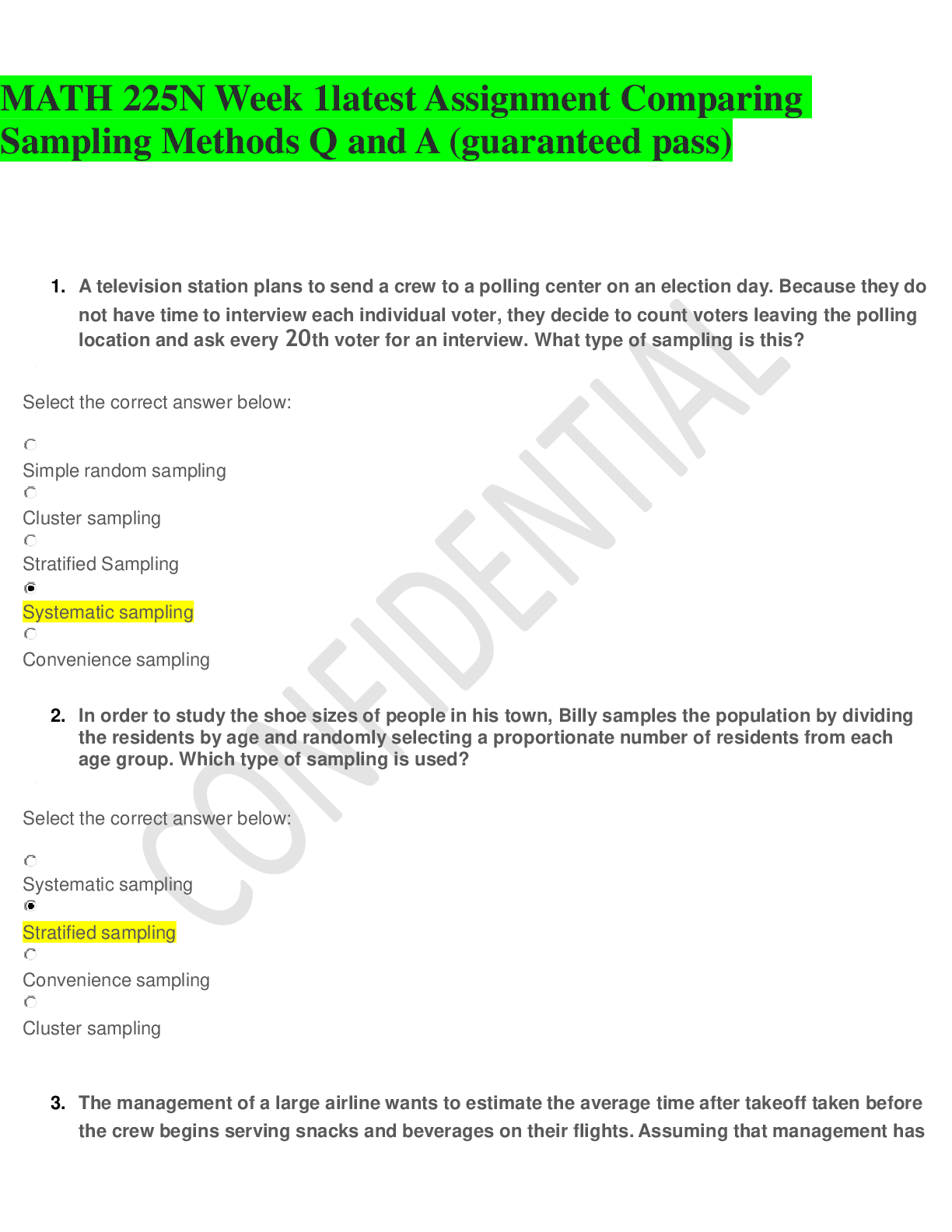*NURSING > QUESTIONS & ANSWERS > MAT CHILD 1001|Chapter 4 – Prenatal Care and Adaptation to Pregnancy Quiz, Complete Answers, Alrea (All)
MAT CHILD 1001|Chapter 4 – Prenatal Care and Adaptation to Pregnancy Quiz, Complete Answers, Already Graded A.
Document Content and Description Below
Chapter 4 – Prenatal Care and Adaptation to Pregnancy Quiz 1. A woman who is 7 weeks pregnant tells the nurse that this is not her first pregnancy. She has a 2-year-old son and had one previous spo... ntaneous abortion. Using the TPAL system, the patient's obstetric history would be recorded as: a. gravida 2 para 20120. b. gravida 3 para 10011. c. gravida 3 para 10110. d. gravida 2 para 11110. 2. A woman asks the nurse about the frequency of prenatal visits. In an uncomplicated pregnancy, the nurse would tell her that appointments are scheduled: a. every 3 weeks until the 6th month, then every 2 weeks until delivery. b. every 4 weeks until the 7th month, after which appointments will become more frequent. c. monthly until the 8th month. d. every 2 to 3 weeks for the entire pregnancy. 3. During the physical examination for the first prenatal visit, it is noted that Chadwick's sign is present. This refers to the: a. bluish or purplish discoloration of the vulva, vagina, and cervix. b. presence of early fetal movements. c. darkening of the areola and breast tenderness. d. palpation of the fetal outline. 4. After the examination is completed, the patient asks the nurse why Chadwick's sign occurs during pregnancy. The nurse would explain that it is caused by the: a. enlargement of the uterus. b. progesterone action on the breasts. c. increasing activity of the fetus. d. vascular congestion in the pelvic area. 5. The nurse has explained physiological changes that occur during pregnancy. Which statement indicates that the woman understands the information? a. "Blood pressure goes up toward the end of pregnancy." b. "My breathing will get deeper and a little faster." c. "I'll notice a decreased pigmentation in my skin." d. "There will be a curvature in the upper spine area." 6. A woman reports that her last normal menstrual period began on August 5, 2010. Using Nägele's rule, her expected date of delivery would be _____, 2011. a. April 30 b. May 5 c. May 12 d. May 26 7. During the second prenatal visit, the nurse attempts to locate the fetal heartbeat with an electronic Doppler device. When this instrument is used, fetal heart tones can be detected as early as _____ weeks. a. 4 b. 8 c. 10 d. 14 8. In a routine prenatal visit, the nurse examining a patient who is 37 weeks pregnant notices that the fetal heart rate (FHR) has dropped to 120 beats/min from a rate of 160 beats/min earlier in the pregnancy. The nurse should: a. ask if the patient has taken a sedative. b. notify the physician. c. turn the patient to her right side. d. record rate as a normal finding. 9. A woman's prepregnant weight is average for her height. The nurse would advise the woman that her recommended weight gain during pregnancy would be _____ pounds. a. 10 to 20 b. 15 to 25 c. 25 to 35 d. 28 to 40 10. When the nurse tells a pregnant woman that she needs 1,200 mg of calcium daily during pregnancy, the woman responds, "I don't like milk." What dietary adjustments could the nurse recommend? a. Increase intake of organ meats. b. Eat more green leafy vegetables. c. Choose more fresh fruits, particularly citrus fruits. d. Include molasses and whole-grain breads in the diet. 11. A pregnant woman is experiencing nausea in the early morning. What recommendations would the nurse offer to alleviate this symptom? a. Eat three well-balanced meals per day and limit snacks. b. Drink a full glass of fluid at the beginning of each meal. c. Have crackers handy at the bedside, and eat a few before getting out of bed. d. Eat a bland diet and avoid concentrated sweets. 12. The patient who is 28 weeks pregnant shows a 10-pound weight gain from 2 weeks ago. The nurse should initially: a. assess food intake. b. weigh the patient again. c. take the blood pressure. d. notify the physician 13. The patient remarks that she has heard some foods will enhance brain development of the fetus. The nurse replies that foods high in docosahexaenoic acid (DHA) are thought to enhance brain development. Such foods include: a. fried fish. b. olive oil. c. red meat. d. leafy green vegetables. 14. The nurse encourages adequate intake of folic acid because it is thought to decrease the incidence of: a. structural heart defects. b. craniofacial deformities. c. limb deformities. d. neural tube defects. 15. A woman tells the nurse that she is quite sure she is pregnant. The nurse recognizes which as a positive sign of pregnancy? a. Amenorrhea b. Uterine enlargement c. HCG detected in the urine d. Fetal heartbeat 16. At her initial prenatal visit a woman asks, "When can I hear the baby's heartbeat?" The nurse would respond that the fetal heartbeat can be auscultated with a specially adapted stethoscope or fetoscope at _____ weeks. a. 4 b. 12 c. 18 d. 24 17. A woman pregnant for the first time asks the nurse, "When will I begin to feel the baby move?" The nurse would answer: a. "You may notice the baby moving around the 4th to 5th month." b. "Quickening varies with every woman." c. "You'll feel something by the end of the first trimester." d. "The baby will be big enough for you to feel in your 8th month." 18. The patient who is 40 weeks pregnant complains of a sense of weakness and dizziness when she lies on her back. The nurse assesses this as an indication of: a. supine hypotension. b. orthostatic hypotension. c. gestational hypertension. d. pseudoanemia. 19. A pregnant woman inquires about exercising during pregnancy. In planning the teaching for this woman, the nurse should include what information? a. Exercise elevates the mother's temperature and improves fetal circulation. b. Exercise increases catecholamines, which can prevent preterm labor. c. A regular schedule of moderate exercise during pregnancy is beneficial. d. Pregnant women should limit water intake during exercise 20. An ultrasound confirms that a 16-year-old girl is pregnant. The nurse recognizes the need for prenatal care and counseling for adolescents because: a. a pregnant adolescent is experiencing two major life transitions at the same time. b. adolescents who get pregnant are more likely to have other chronic health problems. c. adolescents are at greater risk for multifetal pregnancies. d. at this age, a pregnant adolescent will accept the nurse's advice. 21. The nurse explains that the number of years between menarche and the date of conception is known as _____ age. a. gynecological b. fertile c. conception d. gravid 22. The woman who becomes pregnant for the first time after the age of ____ years is described as an "elderly primip." a. 25 b. 28 c. 30 d. 35 23. The nurse explains that the softening of the cervix and vagina is a probable sign of pregnancy called _____ sign. a. Chadwick's b. Hegar's c. McDonald's d. Goodell's 24. A woman who is 36 weeks pregnant tells the nurse she plans to fly to Hawaii, which is a 12-hour flight. What would the nurse recommend that the patient do during the flight? Select all that apply. a. Wear tight fitting clothing to promote venous return. b. Eat a large meal before boarding the flight. c. Request a seat with greater leg room. d. Drink at least 4 ounces of water every hour. e. Get up and walk around the plane frequently 25. The nurse cautions the patient that, because of hormonal changes in late pregnancy, the pelvic joints relax. What does this result in? Select all that apply. a. Waddling gait b. Joint instability c. Urinary frequency d. Back pain e. Aching in cervical spine 26. The nurse assesses the progress from the announcement stage of fatherhood to the acceptance stage when the patient reports which action(s) by the father? Select all that apply. a. Goes fishing every afternoon b. Has revised his financial plan c. Spends leisure time with his friends d. Traded his sports car for a sedan e. Helped select a crib 27. What should the nurse do for the prenatal patient in terms of prenatal care? Select all that apply. a. Offer nutritional counseling. b. Reinforce responsibility of parenthood. c. Reduce risk factors. d. Improve health practices. e. Make financial arrangements for delivery. 28. The nurse recognizes which behavior characteristic(s) of women in their first trimester of pregnancy? Select all that apply. a. Showing off her sonogram photos b. Ambivalence about pregnancy c. Emotional and labile mood d. Focusing on her infant e. Fatigue 29. The nurse reminds the prenatal patient that she should add __300__ kcal to her daily intake to nourish the fetus. 30. True or False - Prenantal and Antepartum both mean the same thing. Time between conception and birth. 31. The goal of the prenantal period is to provide ambulatory care to enhance the well being and prevent illness in: A) The mother B) The father C) the child D) A and C 32. The Pregnant Patient's Bill of Rights involves partnering with the woman to: A) provide a less painful labor B) participate in decisions C) lower the cost of healthcare D) prevent lawsuits 33. Prenatal care decreased maternal mortality rates by 40%. It was formalized in: A) 1900 B) 1910 C) 1920 D) 1930 34. Prenatal care today is focused on collaboration, and is based on patient choices and input 35. Which of the following does not belong in the Health Status assessment: A) Financial B) Physical C) Psychological D) Emotional 36. Which of the following does not belong with Health Services: A) Available B) Accessible C) Anticipatory D) Acceptable E) Affordable 37. When assessing socioeconomic status, one must be sure that income meets the needs for: A) food B) Shelter C) Clothing D) Insurance E) All of the above 38. To ensure adequate dietary intake, which is NOT necessary of the food supply: A) good quality B) palatable C) available D) affordable 39. When assessing prenatal self-care, look for Program adherence/compliance, active involvement, collaboration, and: A) wanted pregnancy B) employment C) grooming habits D) A and C E) All of the above 40. Personal factors to assess in prenatal care include A) genetics B) culture C) race/ethnicity D) language E) All of the above 41. When assessing the family, be aware of size, composition, stability, and: A) location B) gestational age C) support available D) A and C E) All of the above 42. Education of the parents should include all of the following EXCEPT: A) Knowledge B) Skills C) Comprehension D) socioeconomic status E) Language F) Perinatal Education 43. The environment of the parents includes home, community, and: A) exposure to teratogens B) neighbors C) loud noises D) family 44. True or False: For medical and insurance purposes, a woman is pregnant if she notices amenorrhea or absence of menses for 1 month or more. 45. Physiological changes in pregnancy occur as a result of shifts in: A) pelvic girdle B) hormones C) sexual satisfaction D) new muscle growth 46. This organ produces almost all of the hormones related to pregnancy: A) hypothalamus B) pineal gland C) placenta D) ovaries E) uterus 47. True or False: Pregnancy causes anatomical changes to a woman's body, but not physiological 48. Pregnancy changes occur from a response of the woman's body to A) hormonal changes B) skeletal changes C) fetal growth D) maternal adaptation to A and C 49. Organ changes during pregnancy are A) a result of illness B) result of normal physiology C) usually not present D) A and C 50. False: Normally at 40 weeks, the fundus of the uterus is at its highest point during pregnancy. 51. Which of the following hormones does not change during pregnancy A) testosterone B) estrogen C) relaxin D) oxytocin E) progesterone F) HcG G) HpL H) prostaglandins I) prolactin 52. hCG: Produced by syncytiotrophoblasts, this hormone is present 8 days post conception and peaks 60-90 days. Maintains corpus luteum in early pregnancy and stimulates production of estrogen and progesterone until placenta is developed. Prevents menstruation and contributes to morning sickness. This is what home pregnancy tests look for. 53. Estrogen: Secreted by the placenta, this hormone controls growth/function of the uterus, decreases peripheral vascular resistance, increases pliability of connective tissue, increases response to oxytocin stimulation, causes cervical dilation, increases plasma volume, and causes mood swings. 54. Progesterone: This hormone is produced by the corpus luteum (7 weeks), then the maternal-fetal-placental unit. Influences development of decidual cells, suppresses maternal immune response to fetus, decreases uterine contractility, relaxes smooth muscle, resets hypothalmic centers. Prevents sloughing of endometrium as menses, prevents uterine contractions, decreases maternal alveolar and arterial Pco2, causes physiological hyperventilation. 55. HPL: This hormone is produced by syncytoitrophoblasts in an amount related to fetal and placental weight. Influences glucose metabolism (anti-insulin), and increases protein synthesis. In this way, it provides glucose protein to fetus, and prepares for lactation. 56. Relaxin: This hormone is produced by the ovaries, corpus luteum, and placenta. It inhibits uterine activity, softens the cervix, and shortens/increases pelvic/pubic joints. Prevents preterm labor and facilitates cervical ripening. 57. Which of these acronyms does not involve birth of the baby? A) EDC B) EBD C) EDD D) EDB 58. Nagele's rule to determine delivery date involves subtracting 3 months from the last menstrual period and then adding this number of days A) 3 B) 7 C) 10 D) 14 59. The use of ultrasound is used to establish a positive diagnosis via outline of the fetus at: A) 5 weeks B) 5 months C) 3 weeks D) 3 months 60. A woman with 3 living children is: A) nullipara B) multipara C) primipara D) unknown 61. A woman who has been pregnant 6 times is: A) multigravida B) primigravida C) nulligravida D) unknown 62. A woman who is multipara is: A) nulligravida B) multigravida C) primigravida D) unknown 63. A woman who is primigravida and still pregnant is A) multipara B) primigravida C) nullipara D) unknown 64. A woman who is nullipara is A) primigravida B) multigravida C) nulligravida D) unknown 65. Presumptive signs of pregnancy include all of the following EXCEPT: A) amenorrhea B) nausea/vomiting C) breast sensitivity D) urinary symptoms E) heightened energy F) fatigue 66. Probable (more indicative than presumptive) signs of pregnancy include all of the following EXCEPT: A) diaphoresis B) abdominal enlargement C) uterine enlargement D) positive pregnancy test C) cervical changes 67. Positive signs of pregnancy include all of the following EXCEPT: A) fetal heart tones B) fetal movement observed or palpated C) confirmation via ultrasound D) confirmation via blood test. True or False - human chorionic gonadotrophic (hCG) hormone is used by pregnancy tests. 68. In an immunoassay pregnancy test, the antibody reaction between hCG-coated particles and a first morning urine specimen is used during the following times after missed period: A) 1-5 days B) 4-10 days C) 10-20 days D) 30-60 days 69. In a radioimmunoassay (RIA) a blood test for the B-unit of hCG is most sensitive in the following time intervals after conception: A) 6-10 days B) 11-15 days C) 16-30 days D) 31-60 days 70. The most common over-the-counter home pregnancy test used after a missed period is: A) Immunoassay B) Radioimmunoassay C) Urine creatinine D) Enzyme-linked immunosorbant assay 71. Increase in uterine size is accomplished via: A) hypertrophy B) hyperplasia C) hyperalimentation D) A and B E) All of the above 72. True or False - The uterus is always contracting 73. True or False - During pregnancy, the cervix hardens and decreases mucus production 74. True or False - During pregnancy, the vagina/vulva increases in vascularity 75. True or False - During pregnancy, no further ova are produced. 76. What causes the change in posture of a pregnant woman? A) loosened ligaments B) skeletal muscle atrophy C) shifted center of gravity D) increased hormones 77. True or False - Uterine ligaments and abdominal muscles become tender as they become tighter 78. Syncope in pregnant women is often a result of: A) orthostatic hypotension B) hypoglycemia C) low hematocrit D) A and B E) All of the above 79. During pregnancy, the heart is displaced in the following ways: A) Upward B) Forward C) Right D) Left E) A, B, & C F) A, B, & D 80. During pregnancy, cardiac volume increases: A) 5% B) 10% C) 15% D) 20% 81. True or False - Murmurs can be auscultated in 19% of pregnant women 82. By the end of the second trimester, cardiac output increases: A) 15-30% B) 30-50% C) 50-100% D) Does not increase 83. True or False - heart rate increases by 10-15 beats per minute during pregnancy. 84. During pregnancy, which of the following changes to the respiratory system is NOT seen: A) Increased chest circumference B) Respirations become thoracic rather than abdominal C) Tital volume increases to 700 ml D) O2 consumption decreases 85. Influence of hormones create a change in physical space, stomach, and intestines. Which of the following discomforts is NOT caused: A) cardiac arrhythmia B) Heartburn C) Nausea D) Vomiting E) All of these are seen 86. True or False - McBurney's Point (position of appendix) remains constant throughout pregnancy. 87. True or False - bladder size increases during pregnancy to compensate for pressure from the expanding uterus 88. Changes to the urinary system during pregnancy include: A) increased GFR B) Increased tubule glucose reabsorption C) Decreased GFR D) B and C 89. False: Integumentary system changes during pregnancy include the decreased pigmentation of nipples and areola 90. Which of the following is NOT often seen during pregnancy: A) increased sweat B) Increased sebaceous gland activity C) Stretch marks D) Appearance of linea negra E) All are seen 90. True or False - nutrition prior to pregnancy has effect on fetus 91. True or False - Baby's size is not affected by mother's diet 92. True or False - Folic Acid and Iron supplements are commonly given during prenatal period 93. True or False - Women can expect a 35 pound weight gain during pregnancy 94. This is the process by which a living organism assimilates and uses food: A) metabolism B) growth C) nutrition D) digestion 95. True or False - a pregnant woman does not need to increase her diet. An increase in calories is only necessary during lactation. 96. How many extra calories are needed during pregnancy: A) 300 B) 400 C) 500 D) None 97. The following supplement is given to prevent neural tube defects: A) Vitamin D B) Iron C) Vitamin B12 D) Folic Acid 98. Iron supplements of 30 mg daily is given to: A) Treat constipation B) Prevent anemia C) Increase strength D) Strengthen bone 99. High protein diet during postpartum period given to aid in: A) stimulating kidney function B) providing osmotic pressure in breast milk C) repairing tissue D) gaining weight 100. Lactation requires how many additional calories: A) 300 B) 500 C) 700 D) 2500 101. Fiber is important in postpartum nutrition to: A) provide calories B) augment immune function C) repair tissue D) none of the above 102. True or False - fluid intake during postpartum period should be 2000 ml per day 103. Which of the following is NOT a risk factor for inadequate nutritional status: A) underweight B) preexisting anemia C) anorexia, bulimia D) alcohol E) All are risk factors 104. Which of the following is NOT a risk factor for inadequate nutritional status: A) substance abuse B) Nausea/vomiting C) smoking D) cultural influences E) Socioeconomic status F) All are risk factors 105. Which of the following is NOT a complication of inadequate nutrition during pregnancy: A) excessive or insufficient weight gain B) anemia C) compromised fetal development D) low birth weight E) All are complications of inadequate nutrition [Show More]
Last updated: 1 year ago
Preview 1 out of 9 pages
Instant download
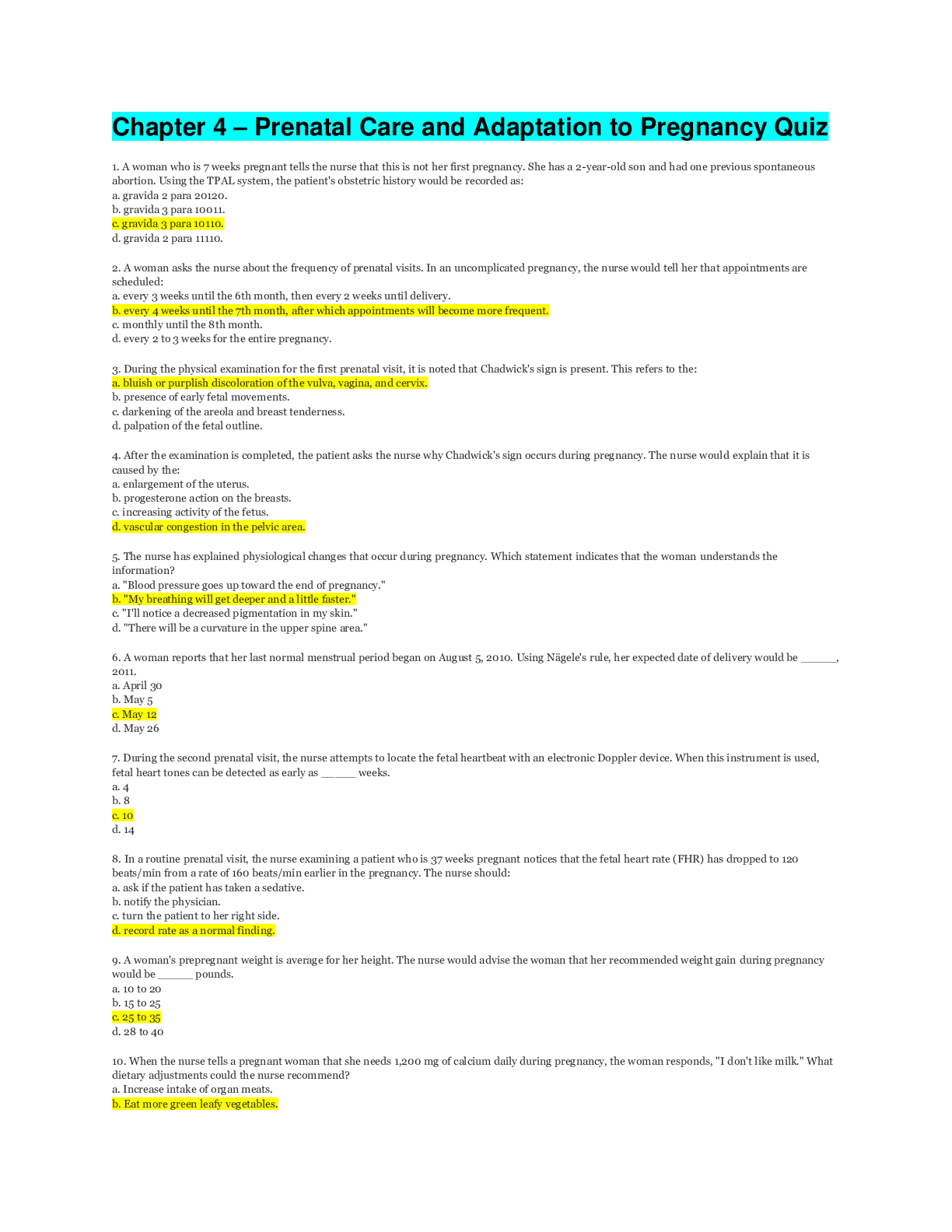
Buy this document to get the full access instantly
Instant Download Access after purchase
Add to cartInstant download
Reviews( 0 )
Document information
Connected school, study & course
About the document
Uploaded On
Jun 10, 2020
Number of pages
9
Written in
Additional information
This document has been written for:
Uploaded
Jun 10, 2020
Downloads
0
Views
150

.png)



